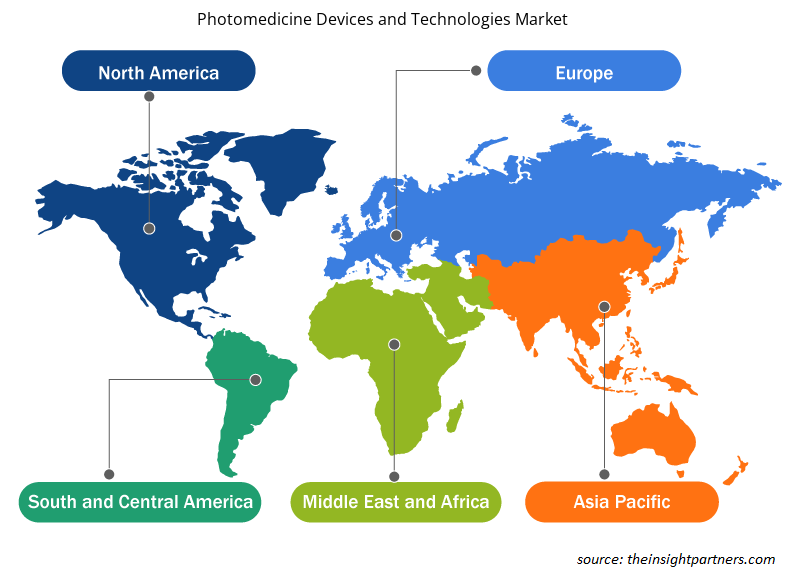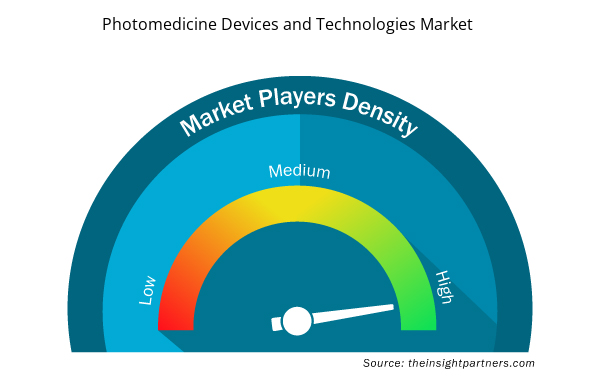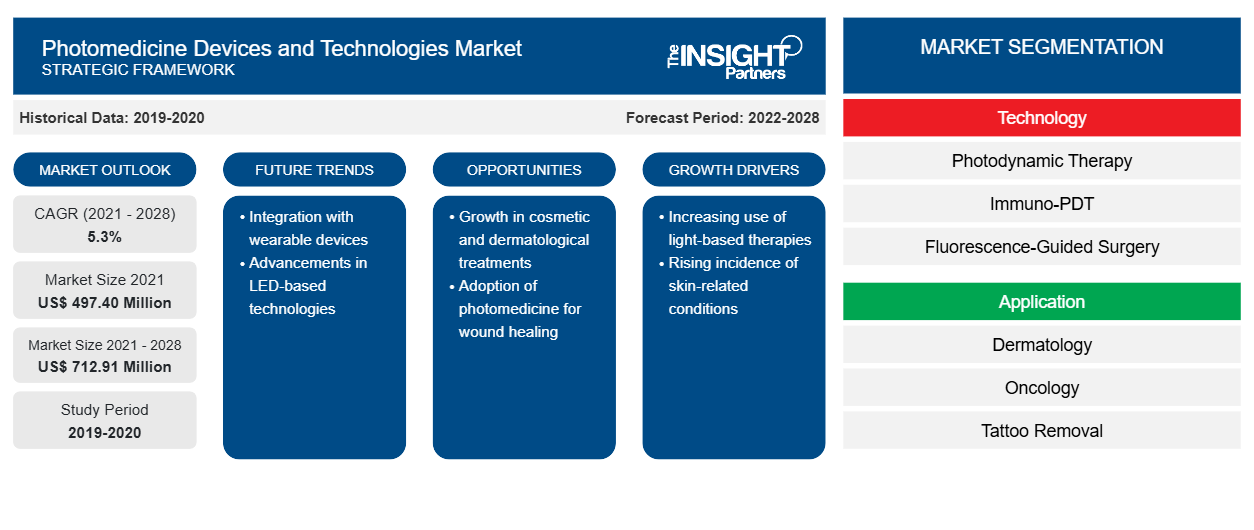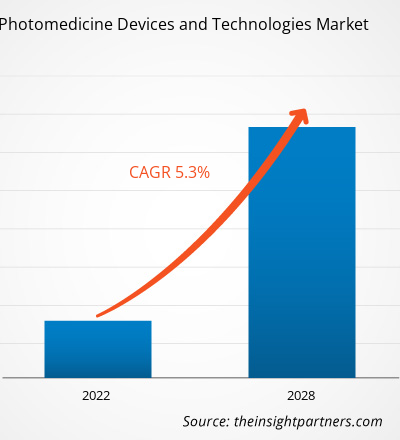Le marché des dispositifs et technologies de photomédecine devrait atteindre 712,91 millions de dollars américains d'ici 2028, contre 497,40 millions de dollars américains en 2021 ; il devrait croître à un TCAC de 5,3 % de 2021 à 2028.
La photomédecine est une discipline de la médecine qui utilise la photobiologie et la lumière pour soigner des maladies et d'autres problèmes médicaux. Des lasers, une lumière à spectre complet, des lampes dichroïques, une lumière polarisée polychromatique, des diodes électroluminescentes et des lampes fluorescentes sont utilisés dans ce traitement pour exposer les personnes à des longueurs d'onde de lumière spécifiques. La photomédecine est une nouvelle option thérapeutique pour une variété de troubles qui a surpassé l'ancienne technique de diagnostic et de détection d'une maladie. Des facteurs tels qu'une applicabilité plus large de la photomédecine et une augmentation de la demande de thérapies mini-invasives et non invasives stimulent la croissance du marché des dispositifs et technologies de photomédecine . Cependant, le cadre réglementaire strict des technologies de photomédecine freine la croissance du marché.
Informations sur le marché
L'augmentation de la demande de thérapies mini-invasives et non invasives stimule la croissance du marché des dispositifs et technologies de photomédecine
La popularité des procédures médicales mini-invasives a augmenté ces dernières années, en raison de la nécessité de minuscules incisions, d'une récupération plus rapide des patients et d'un inconfort moindre pour les patients. De plus, les procédures de photomédecine offrent des avantages tels que moins de douleur, moins de traumatismes aux muscles, aux nerfs, aux tissus et aux organes, moins de saignements et de cicatrices et des blessures minimales aux tissus. Selon l'American Society of Plastic Surgeons, en 2020, plus de 15,6 millions d'interventions esthétiques mini-invasives ont été réalisées aux États-Unis. Au total, 13 281 235 interventions esthétiques mini-invasives ont été réalisées en 2020. Dans le top 5 des interventions esthétiques mini-invasives, le traitement par lumière pulsée intense (IPL) a remplacé le traitement d'épilation au laser en enregistrant plus de 827 000 interventions IPL réalisées en 2020. Selon un rapport mondial publié par l'International Society of Aesthetic Plastic Surgery (ISAPS), le nombre d'interventions esthétiques et cosmétiques réalisées dans le monde est passé de 20 236 901 en 2014 à 23 266 374 en 2018.
Personnalisez ce rapport en fonction de vos besoins
Vous bénéficierez d'une personnalisation gratuite de n'importe quel rapport, y compris de certaines parties de ce rapport, d'une analyse au niveau des pays, d'un pack de données Excel, ainsi que de superbes offres et réductions pour les start-ups et les universités.
- Obtenez les principales tendances clés du marché de ce rapport.Cet échantillon GRATUIT comprendra une analyse de données, allant des tendances du marché aux estimations et prévisions.
Informations basées sur la technologie
Sur la base de la technologie, le marché des dispositifs et technologies de photomédecine est segmenté en thérapie photodynamique (PDT), immuno-PDT (thérapies photoimmunes), chirurgie guidée par fluorescence, diagnostic photodynamique, photobiomodulation (lumières lasers) et autres technologies. Le segment de la thérapie photodynamique détenait la plus grande part du marché en 2021 et devrait enregistrer le TCAC le plus élevé au cours de la période de prévision.
Informations basées sur les applications
En fonction des applications, le marché des dispositifs et technologies de photomédecine est segmenté en esthétique et dermatologie, oncologie, ophtalmologie, neurologie, gestion de la douleur, cicatrisation des plaies et autres applications. Le marché du segment esthétique et dermatologie est en outre segmenté en épilation, détatouage, resurfaçage de la peau et autres applications. Le segment esthétique et dermatologie détenait la plus grande part de marché en 2021, et le même segment devrait enregistrer le TCAC le plus élevé du marché au cours de la période de prévision.
Diverses entreprises opérant sur le marché des appareils et technologies de photomédecine adoptent des stratégies telles que les lancements de produits, les fusions et acquisitions, les collaborations, les innovations de produits et les extensions de portefeuille de produits pour étendre leur empreinte dans le monde entier, maintenir la marque et répondre à la demande croissante des utilisateurs finaux.
Appareils et technologies de photomédecine
Aperçu régional du marché des dispositifs et technologies de photomédecine
Les tendances et facteurs régionaux influençant le marché des dispositifs et technologies de photomédecine tout au long de la période de prévision ont été expliqués en détail par les analystes d’Insight Partners. Cette section traite également des segments et de la géographie du marché des dispositifs et technologies de photomédecine en Amérique du Nord, en Europe, en Asie-Pacifique, au Moyen-Orient et en Afrique, ainsi qu’en Amérique du Sud et en Amérique centrale.

- Obtenez les données régionales spécifiques au marché des dispositifs et technologies de photomédecine
Portée du rapport sur le marché des dispositifs et technologies de photomédecine
| Attribut de rapport | Détails |
|---|---|
| Taille du marché en 2021 | 497,40 millions de dollars américains |
| Taille du marché d'ici 2028 | 712,91 millions de dollars américains |
| Taux de croissance annuel moyen mondial (2021-2028) | 5,3% |
| Données historiques | 2019-2020 |
| Période de prévision | 2022-2028 |
| Segments couverts | Par technologie
|
| Régions et pays couverts | Amérique du Nord
|
| Leaders du marché et profils d'entreprises clés |
|
Densité des acteurs du marché des dispositifs et technologies de photomédecine : comprendre son impact sur la dynamique commerciale
Le marché des dispositifs et technologies de photomédecine connaît une croissance rapide, tirée par la demande croissante des utilisateurs finaux en raison de facteurs tels que l'évolution des préférences des consommateurs, les avancées technologiques et une plus grande sensibilisation aux avantages du produit. À mesure que la demande augmente, les entreprises élargissent leurs offres, innovent pour répondre aux besoins des consommateurs et capitalisent sur les tendances émergentes, ce qui alimente davantage la croissance du marché.
La densité des acteurs du marché fait référence à la répartition des entreprises ou des sociétés opérant sur un marché ou un secteur particulier. Elle indique le nombre de concurrents (acteurs du marché) présents sur un marché donné par rapport à sa taille ou à sa valeur marchande totale.
Les principales entreprises opérant sur le marché des dispositifs et technologies de photomédecine sont :
- Lasers Alma
- Beurer GmbH
- Biolitec SA
- Lumenis
- Quantel Médical
Avis de non-responsabilité : les sociétés répertoriées ci-dessus ne sont pas classées dans un ordre particulier.

- Obtenez un aperçu des principaux acteurs du marché des dispositifs et technologies de photomédecine
Marché des dispositifs et technologies de photomédecine – par technologie
- Thérapie photodynamique (PDT)
- Immuno-PDT (Thérapies photo-immunes)
- Chirurgie guidée par fluorescence
- Diagnostic photodynamique
- Photobiomodulation (Lumières Lasers)
- Autres technologies
Marché des dispositifs et technologies de photomédecine – par application
- Esthétique et Dermatologie
- Épilation
- Suppression de tatouage
- Resurfaçage de la peau
- Autres applications
- Oncologie
- Ophtalmologie
- Neurologie
- Gestion de la douleur
- Cicatrisation des plaies
- Autres applications
Marché des dispositifs et technologies de photomédecine – par géographie
- Amérique du Nord
- NOUS
- Canada
- Mexique
- Europe
- France
- Allemagne
- Italie
- ROYAUME-UNI
- Espagne
- Reste de l'Europe
- Asie-Pacifique (APAC)
- Chine
- Inde
- Corée du Sud
- Japon
- Australie
- Reste de l'Asie-Pacifique
- Moyen-Orient et Afrique (MEA)
- Afrique du Sud
- Arabie Saoudite
- Émirats arabes unis
- Reste du Moyen-Orient et de l'Afrique
- Amérique du Sud (SAM)
- Brésil
- Argentine
- Reste de l'Amérique du Sud et de l'Amérique centrale
Profils d'entreprise
- Lasers Alma
- Beurer GmbH
- Biolitec SA
- Lumenis
- Quantel Médical
- THOR Photomédecine Ltée
- Verilux Inc
- Candela Médical
- PHILIPS SA, CONSTANTINE
- Société Iridex
- Analyse historique (2 ans), année de base, prévision (7 ans) avec TCAC
- Analyse PEST et SWO
- Taille du marché Valeur / Volume - Mondial, Régional, Pays
- Industrie et paysage concurrentiel
- Ensemble de données Excel



Report Coverage
Revenue forecast, Company Analysis, Industry landscape, Growth factors, and Trends

Segment Covered
This text is related
to segments covered.

Regional Scope
North America, Europe, Asia Pacific, Middle East & Africa, South & Central America

Country Scope
This text is related
to country scope.
Questions fréquemment posées
Global photomedicine devices and technologies market is segmented by region into North America, Europe, Asia Pacific, Middle East & Africa and South & Central America. In North America, the U.S. is the largest market for photomedicine devices and technologies. The US is estimated to hold the largest share in the photomedicine devices and technologies market during the forecast period. Whereas, Asia Pacific is the fastest growing region during the forecast period with highest CAGR rate of 6.1%. The growth of Asia Pacific photomedicine devices and technologies market is owing to, increasing burden of chronic diseases such as cancer, rise in demand for minimally invasive surgical procedures and growing adoption of photomedicine.
The photomedicine devices and technologies market majorly consists of the players such as Alma Lasers, Beurer GmbH., Biolitec AG, Lumenis, Quantel Medical, THOR Photomedicine Ltd, Verilux Inc, Candela Medical, KONINKLIJKE PHILIPS N.V., and Iridex Corporation, among others
The photodynamic therapy segment dominated the global photomedicine devices and technologies market and held the largest revenue share of 24.82% in 2021.
The aesthetics and dermatology segment dominated the global photomedicine devices and technologies market and accounted for the largest revenue share of 27.72% in 2021.
Photomedicine is a discipline of medicine that uses photobiology and light to cure diseases and other medical conditions. Photomedicine is the use of lasers, full-spectrum light, dichroic lamps, polychromatic polarized light, light-emitting diodes, and fluorescent lamps to expose people to specific wavelengths of light. Photomedicine is a new therapy option for a variety of disorders that has outperformed the old technique of diagnosing and detecting a condition.
Key factors that are driving the growth of this market are wider applicability of photomedicine and rise in demand for minimally invasive and non-invasive therapies.
Trends and growth analysis reports related to Life Sciences : READ MORE..
The List of Companies - Photomedicine Devices and Technologies Market
- Alma Lasers
- Beurer GmbH
- Biolitec AG
- Lumenis
- Quantel Medical
- THOR Photomedicine Ltd
- Verilux Inc
- Candela Medical
- KONINKLIJKE PHILIPS N.V
- Iridex Corporation
The Insight Partners performs research in 4 major stages: Data Collection & Secondary Research, Primary Research, Data Analysis and Data Triangulation & Final Review.
- Data Collection and Secondary Research:
As a market research and consulting firm operating from a decade, we have published and advised several client across the globe. First step for any study will start with an assessment of currently available data and insights from existing reports. Further, historical and current market information is collected from Investor Presentations, Annual Reports, SEC Filings, etc., and other information related to company’s performance and market positioning are gathered from Paid Databases (Factiva, Hoovers, and Reuters) and various other publications available in public domain.
Several associations trade associates, technical forums, institutes, societies and organization are accessed to gain technical as well as market related insights through their publications such as research papers, blogs and press releases related to the studies are referred to get cues about the market. Further, white papers, journals, magazines, and other news articles published in last 3 years are scrutinized and analyzed to understand the current market trends.
- Primary Research:
The primarily interview analysis comprise of data obtained from industry participants interview and answers to survey questions gathered by in-house primary team.
For primary research, interviews are conducted with industry experts/CEOs/Marketing Managers/VPs/Subject Matter Experts from both demand and supply side to get a 360-degree view of the market. The primary team conducts several interviews based on the complexity of the markets to understand the various market trends and dynamics which makes research more credible and precise.
A typical research interview fulfils the following functions:
- Provides first-hand information on the market size, market trends, growth trends, competitive landscape, and outlook
- Validates and strengthens in-house secondary research findings
- Develops the analysis team’s expertise and market understanding
Primary research involves email interactions and telephone interviews for each market, category, segment, and sub-segment across geographies. The participants who typically take part in such a process include, but are not limited to:
- Industry participants: VPs, business development managers, market intelligence managers and national sales managers
- Outside experts: Valuation experts, research analysts and key opinion leaders specializing in the electronics and semiconductor industry.
Below is the breakup of our primary respondents by company, designation, and region:

Once we receive the confirmation from primary research sources or primary respondents, we finalize the base year market estimation and forecast the data as per the macroeconomic and microeconomic factors assessed during data collection.
- Data Analysis:
Once data is validated through both secondary as well as primary respondents, we finalize the market estimations by hypothesis formulation and factor analysis at regional and country level.
- Macro-Economic Factor Analysis:
We analyse macroeconomic indicators such the gross domestic product (GDP), increase in the demand for goods and services across industries, technological advancement, regional economic growth, governmental policies, the influence of COVID-19, PEST analysis, and other aspects. This analysis aids in setting benchmarks for various nations/regions and approximating market splits. Additionally, the general trend of the aforementioned components aid in determining the market's development possibilities.
- Country Level Data:
Various factors that are especially aligned to the country are taken into account to determine the market size for a certain area and country, including the presence of vendors, such as headquarters and offices, the country's GDP, demand patterns, and industry growth. To comprehend the market dynamics for the nation, a number of growth variables, inhibitors, application areas, and current market trends are researched. The aforementioned elements aid in determining the country's overall market's growth potential.
- Company Profile:
The “Table of Contents” is formulated by listing and analyzing more than 25 - 30 companies operating in the market ecosystem across geographies. However, we profile only 10 companies as a standard practice in our syndicate reports. These 10 companies comprise leading, emerging, and regional players. Nonetheless, our analysis is not restricted to the 10 listed companies, we also analyze other companies present in the market to develop a holistic view and understand the prevailing trends. The “Company Profiles” section in the report covers key facts, business description, products & services, financial information, SWOT analysis, and key developments. The financial information presented is extracted from the annual reports and official documents of the publicly listed companies. Upon collecting the information for the sections of respective companies, we verify them via various primary sources and then compile the data in respective company profiles. The company level information helps us in deriving the base number as well as in forecasting the market size.
- Developing Base Number:
Aggregation of sales statistics (2020-2022) and macro-economic factor, and other secondary and primary research insights are utilized to arrive at base number and related market shares for 2022. The data gaps are identified in this step and relevant market data is analyzed, collected from paid primary interviews or databases. On finalizing the base year market size, forecasts are developed on the basis of macro-economic, industry and market growth factors and company level analysis.
- Data Triangulation and Final Review:
The market findings and base year market size calculations are validated from supply as well as demand side. Demand side validations are based on macro-economic factor analysis and benchmarks for respective regions and countries. In case of supply side validations, revenues of major companies are estimated (in case not available) based on industry benchmark, approximate number of employees, product portfolio, and primary interviews revenues are gathered. Further revenue from target product/service segment is assessed to avoid overshooting of market statistics. In case of heavy deviations between supply and demand side values, all thes steps are repeated to achieve synchronization.
We follow an iterative model, wherein we share our research findings with Subject Matter Experts (SME’s) and Key Opinion Leaders (KOLs) until consensus view of the market is not formulated – this model negates any drastic deviation in the opinions of experts. Only validated and universally acceptable research findings are quoted in our reports.
We have important check points that we use to validate our research findings – which we call – data triangulation, where we validate the information, we generate from secondary sources with primary interviews and then we re-validate with our internal data bases and Subject matter experts. This comprehensive model enables us to deliver high quality, reliable data in shortest possible time.


 Obtenez un échantillon gratuit pour ce rapport
Obtenez un échantillon gratuit pour ce rapport